
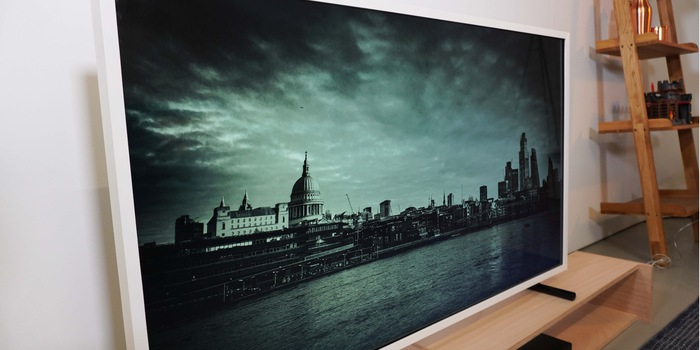
Put to the test: The Frame 3.0 – not just a pretty picture
What do you get when you turn your TV off? A black hole. The Frame is different. Switch it off and it turns into a piece of art. The Frame’s third generation also delivers significantly improved image quality.
When it comes to design or aesthetics, Samsung's Frame is pretty much picture perfect. The black aluminium frame is a bit bulky, but that’s intentional. The television as a whole aims to look like a picture frame worthy of being displayed in a private art gallery. At least when it’s switched off. That’s when the Frame goes into Art Mode, showing a photo or artwork instead of a pitch-black display.
Clever!
Samsung first presented The Frame with its Art Mode in 2017. I found the concept too exciting not to take a closer look at it. My conclusion at the time: Art Mode works better than expected. However, the TV picture is not good enough to justify its hefty price tag.
Fast forward two years and Samsung is launching Frame 3.0 – the third generation of this artistic TV. The main new feature is said to be its improved image quality. I want to double check that. And I want to find out if anything about the Art Mode has changed.
Now featuring QLED. Does that equal better?
What’s new about The Frame is QLED – a nanoparticle-based LCD technology that provides more natural and richer colours than a LCD TV without nanoparticles. Samsung calls the particles Quantum Dots – hence QLED.
And sure enough, I really like the colours in «Jurassic World 2», my reference UHD Blu-ray for testing TVs. I particularly enjoyed the scene in which an erupting volcano blows up the island where Dinopark was located: orange-red, pulsating streams of lava eat their way through the lush greens of the jungle. Huge rocks spewed out by the volcano collide with the fleeing islanders and raise dirt-brown clouds of dust.
I like.
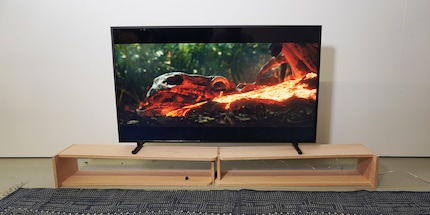
That’s not a given: the brighter the image, the greater the risk of fading colours. In view of the fact that modern televisions are much brighter than they used to be, colour volume has become an important aspect. The nanoparticle technology QLED stands for 100 per cent colour volume. What does that mean? It means that The Frame always produces colours that look exactly as they should – no matter how bright the TV is.
Ironically, when put to the test, The Frame looks dark. The picture is hard to make out. Especially during dark scenes and with the light switched on in my makeshift studio living room. Is The Frame not shining brightly enough?
I ask Samsung and they confirm: The Frame is based on Samsung’s Q60R. In the rtings.com test a peak brightness of 424 nits was measured. That's not much, especially not for an LCD TV. Due to their technology, they normally shine brighter than their OLED competitors. To put this into perspective: LG's C9 OLED has a peak brightness of 726 nits. Samsung's top-of-the-line UHD QLED model, the Q90R, even reaches 1287 nits.
When it comes to The Frame, this means your TV-watching experience could be somewhat dimmed.
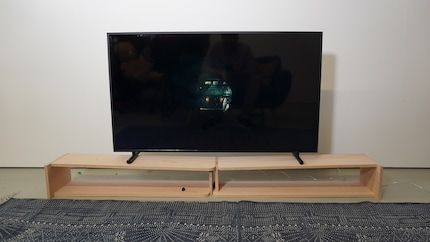
Another feature The Frame’s missing is full array local dimming. This backlight technology provides exceptionally good black levels in LCD televisions. In fact, the frame lacks a little punch when it comes to the vividness of the colours displayed. It’s more of an OLED look that’s reminiscent of the plasma TVs of yesteryear, if you will. So instead of black, you’re seeing dark grey.
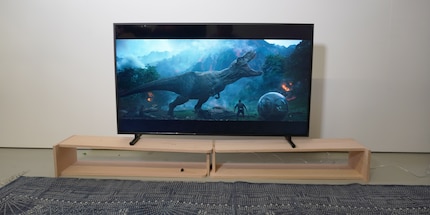
Don’t get me wrong. I’m not unhappy with the picture. The Frame 3.0 has come on in leaps and bounds – not least because of QLED. It’s the price that’s the problem. The Frame costs about the same as an OLED TV or Samsung's best QLED TV. But it doesn’t offer the same picture quality.
In return, Samsung argues, The Frame has Art Mode.
Indeed, Art Mode is definitely the highlight of Frame.
Work of art instead of a black hole?
To cut a long story short: nope, I can't seem to come across anything new in Art Mode. At least nothing obviously new. A sensor still detects ambient light and adjusts the brightness of the image accordingly. The darker the room, the less bright The Frame shines. This does make it look like a real painted or printed picture instead of a high-end screensaver.

The illusion created works extremely well in practice. Especially when you display the selected photos or artwork in full-screen mode.
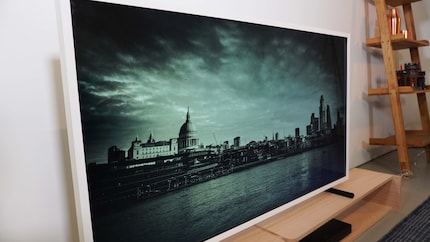
The illusion created is somewhat less impressive when you superimpose the passepartout around the picture.
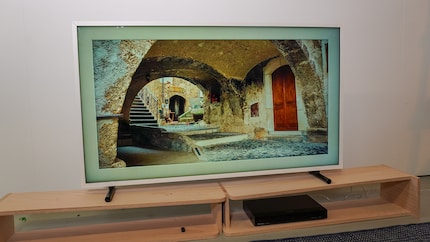
The Frame comes with around 20 pre-installed works of art. They’re available from the Samsung Art Store and are featured in collections of world-famous galleries and museums such as the Tate or Saatchi. For 4.99 francs a month, the range is expanded to over 1,000 works of art. You can sort by artist or topic. «Classic» or «modern», for example.
Alternatively, you can upload your own photos to The Frame via a USB stick or the SmartThings App. This could be exciting for passionate photographers and artists who print their own pictures on Alu Dibond behind acrylic glass. This framing method will easily set you back around six hundred francs if you want good quality. So at least for this target group, The Frame’s steep price is justified.
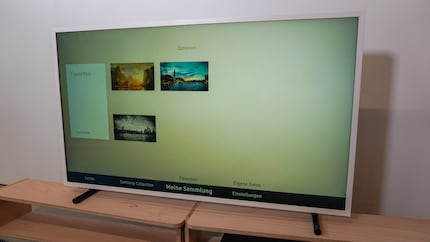
You can create a list of favourites including their rotation from all the works of art available to you – your own or others. You’re the one who decides whether the images should alternate every few minutes or every hour. Or not at all.
Samsung not only put some thought into the range of functions, but also put some thought into what’s included in the delivery: there's the One Connect box for all your external sources, including HDMI, USB and your power supply. The box is connected to the television via a thin, transparent cable. So there’s no cable clutter around your Frame – an important aspect when it comes to aesthetics.
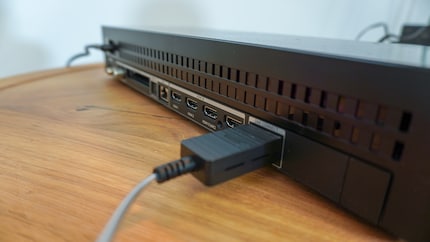
The TV also includes the No Gap Wall Mount. The mount lets you put your Frame up on the wall. Add another frame to The Frame and the real picture illusion is perfect. The frames are available in different colours and sizes but cost around 200 francs each.
Frankly, that’s just way too much.
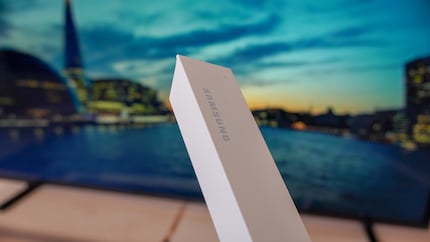
Allow me to say a few words about power consumption in Art Mode: Samsung doesn't give exact figures. Understandably. After all, consumption depends on the image that is displayed and how bright it is in relation to the ambient light. My hands-on test showed Art Mode is usually less bright than normal TV mode. So my guess is that the power consumption is considerably lower than the 124 watt in normal TV mode. In the test carried out by Computer Bild an average power consumption of 40 to 50 watt was quoted. That sounds about right.
By the way, The Frame also features a motion sensor. If no movement is registered in the room, The Frame switches off. As soon as it picks up movement again, it switches back on. This reduces the amount of wasted electricity.
The picture quality is better, but one dampener remains.
So how has my conclusion changed from when I first took a closer look at The Frame? Allow me to remind you of what I mentioned earlier:
«Art Mode works better than expected. However, the TV picture is not good enough to justify its hefty price tag.»
I stand by this conclusion for The Frame 3.0. But there’s a «but»: Back in 2017, The Frame’s picture quality exhibited significant weaknesses. Today, the difference in quality between The Frame 3.0 and TVs in a similar price range without Art Mode is no longer that extreme.
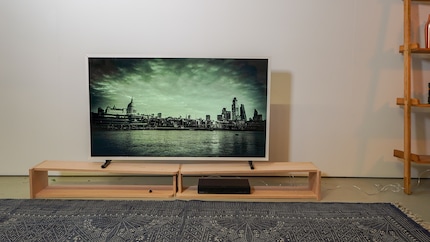
Would I buy The Frame? No. But I’m not the target group. Personally, I expect a TV to be one of the best on the market to justify a high price. In other words, the price tag is the real letdown for me. So who’s The Frame for? Probably for passionate (amateur) photographers and art lovers who attach great importance to TV aesthetics. Art Mode impressed me the first time round and still does.
The thing I fail to understand is why Samsung doesn’t give its Frame a better QLED panel. It's not like photographers or art lovers can’t also be cinema lovers who have high demands towards image quality like I do, right?
I write about technology as if it were cinema, and about films as if they were real life. Between bits and blockbusters, I’m after stories that move people, not just generate clicks. And yes – sometimes I listen to film scores louder than I probably should.










